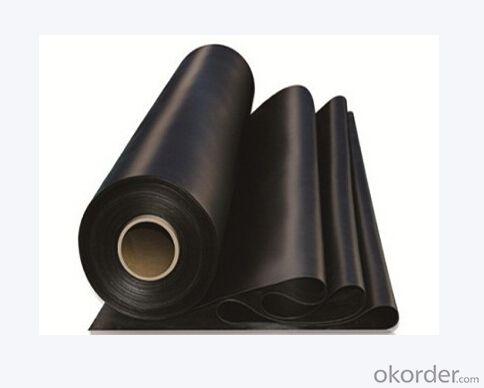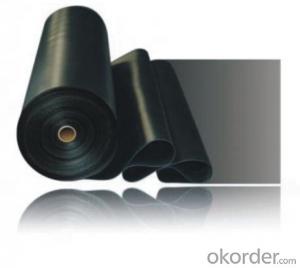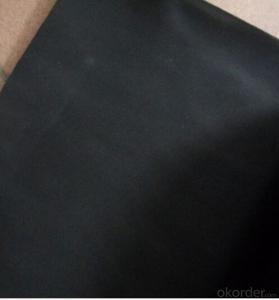EPDM Waterproofing Membrane 30mil/45mil Used for Roof Waterproofing
- Loading Port:
- Qingdao
- Payment Terms:
- TT or LC
- Min Order Qty:
- 2000 m²
- Supply Capability:
- 200000 m²/month
OKorder Service Pledge
OKorder Financial Service
You Might Also Like
1. Introduction of EPDM Waterproofing Membrane:
EPDM waterproof membrane is made from ternary ethylene-propylene rubber, which is designed for waterproofing of exposed and non-exposed applications. The product adopts the world-advanced equipment of cold feeding extrusion and continuous vulcanization technology.
EPDM waterproof membrane is of high elasticity among high polymer waterproof materials and becomes a world popular waterproofing material.
2. Specification of EPDM Waterproofing Membrane:
Type | EPDM Waterproof Membrane | ||
Material | EPDM Rubber | ||
Thickness | 1.2mm | 1.5mm | 2.0mm |
Weight(kg/m2) | 1.54-1.58 | 1.79-1.83 | 2.25-2.29 |
Size | 1.2m(width) * 20m(length)/roll | ||
Type | Vulcanized & Weldable | ||
Pattern | Non-reinforced(homogeneous) | ||
Packing | 24sqm/roll, with plastic bag | ||
Color | Black | ||
Application | Roof, basement, pond, Lake, steel structure roof, swimming pool, underground, tunnel, etc | ||
3. Application of EPDM Waterproofing Membrane:
(1) Roofs, Basement, Toilets
(2) Industrial and civil building waterproofing
(3) Geosynthetic liner for swimming pool, channels, irrigation system
(4) Especially suitable for projects with high requirements in durability, anti-corrosion and deformation

4. Some photos:



RFQ
1) what's your package?
One roll with one plastic bag, several rolls in one pallet
2) what's your payment terms?
T.T, L/C at sight is accepted
3) what's your delivery time?
Within one week against your payment received
- Q:Can a waterproofing membrane be used in hot climates?
- Certainly, hot climates are indeed suitable for the utilization of a waterproofing membrane. In fact, it is imperative to employ a waterproofing membrane in regions characterized by elevated temperatures and strong sunlight. The purpose of this membrane is to safeguard against water infiltration, which is of utmost importance in order to avert any harm to structures such as roofs, balconies, or basements. Furthermore, a top-notch waterproofing membrane is specifically engineered to endure the impacts of temperature fluctuations and UV radiation, guaranteeing its long-lastingness and efficacy even amidst scorching climates. Consequently, it is highly recommended to employ a waterproofing membrane in hot climates to ensure the resilience and integrity of the structures to which it is applied.
- Q:Can a waterproofing membrane be used on different types of surfaces, such as concrete, wood, or metal?
- Yes, a waterproofing membrane can be used on different types of surfaces including concrete, wood, and metal. Waterproofing membranes are designed to provide a protective barrier against moisture and can adhere to various surfaces, ensuring effective waterproofing regardless of the material.
- Q:Can a waterproofing membrane be used in areas with vehicular traffic?
- Certainly! It is indeed possible to utilize a waterproofing membrane in regions frequented by vehicles. In reality, there exist distinct variants of waterproofing membranes meticulously crafted to endure the pressure and motion exerted by automobiles. These specialized membranes, referred to as vehicular or traffic-bearing membranes, are generally composed of sturdier materials like rubberized asphalt or modified bitumen. They are purposefully engineered to furnish a robust and flexible barricade against water and moisture, whilst simultaneously withstanding the burdensome loads and incessant traffic commonly associated with vehicles. Vehicular membranes find widespread application in parking garages, bridges, and other sites where vehicles are commonly found.
- Q:Does a waterproofing membrane require any special precautions during storage?
- Yes, a waterproofing membrane does require special precautions during storage. The membrane should be stored in a dry and cool area, away from direct sunlight and extreme temperatures. It is important to protect the membrane from moisture, as any exposure to water or high humidity levels can compromise its performance. Additionally, the membrane should be stored in a vertical position, and not stacked horizontally or folded, to prevent any damage or deformation. It is also recommended to keep the membrane away from sharp objects or any materials that may puncture or tear it. By following these precautions, the integrity and effectiveness of the waterproofing membrane can be preserved during storage.
- Q:Can a waterproofing membrane be used on bridges?
- Yes, a waterproofing membrane can be used on bridges. It is a common practice to use waterproofing membranes on bridge decks to protect them from water infiltration, which can cause damage and deterioration over time. The membrane acts as a barrier, preventing water from penetrating the bridge deck and protecting the underlying structure.
- Q:Are waterproofing membranes resistant to algae growth?
- Yes, waterproofing membranes are generally resistant to algae growth. Waterproofing membranes are designed to be highly durable and resistant to various environmental factors, including the growth of algae. They are typically made of materials such as PVC, TPO, or EPDM that are inherently resistant to algae and other microbial growth. Additionally, waterproofing membranes are often treated with anti-algae and anti-fungal agents during their manufacturing process to further enhance their resistance to algae growth. However, it is important to note that while waterproofing membranes are resistant to algae growth, they may still require regular cleaning and maintenance to ensure their long-term performance and prevent any potential build-up of dirt or debris that could potentially provide a favorable environment for algae to grow.
- Q:Can a waterproofing membrane be used for concrete tank linings?
- Yes, a waterproofing membrane can be used for concrete tank linings. Waterproofing membranes are commonly used in construction to prevent water penetration and provide a protective barrier. When applied to the interior surfaces of a concrete tank, a waterproofing membrane can effectively prevent water from seeping into the tank and causing damage. This is particularly important for tanks that store liquids or chemicals, as any leakage can lead to contamination or structural deterioration. By using a waterproofing membrane, the tank can be safeguarded against water ingress, ensuring its longevity and maintaining its structural integrity.
- Q:Can a waterproofing membrane be used in permanent or long-term structures?
- Certainly, permanent or long-term structures can indeed make use of a waterproofing membrane. By creating a protective barrier against water infiltration, waterproofing membranes are perfectly suited for structures requiring extended safeguarding against moisture, such as buildings, bridges, tunnels, and underground constructions. These membranes are typically crafted from resilient materials like modified bitumen, PVC, EPDM, or polyurethane, which boast exceptional resistance to water, UV rays, and other environmental elements. A properly installed waterproofing membrane can significantly prolong the lifespan of a structure by thwarting water damage, mold growth, and structural decay. It is therefore highly advisable to utilize a waterproofing membrane in permanent or long-term structures to ensure their robustness and longevity.
- Q:Is the foundation pit waterproofing and the foundation pouring on the working face?
- 3, you say waterproof and pouring concrete conflict? Do not conflict
- Q:Can a waterproofing membrane be used on tunnels with lighting systems?
- Yes, a waterproofing membrane can be used on tunnels with lighting systems. The membrane can effectively protect the tunnel structure from water infiltration while allowing the lighting system to function properly.
1. Manufacturer Overview |
|
|---|---|
| Location | |
| Year Established | |
| Annual Output Value | |
| Main Markets | |
| Company Certifications | |
2. Manufacturer Certificates |
|
|---|---|
| a) Certification Name | |
| Range | |
| Reference | |
| Validity Period | |
3. Manufacturer Capability |
|
|---|---|
| a)Trade Capacity | |
| Nearest Port | |
| Export Percentage | |
| No.of Employees in Trade Department | |
| Language Spoken: | |
| b)Factory Information | |
| Factory Size: | |
| No. of Production Lines | |
| Contract Manufacturing | |
| Product Price Range | |
Send your message to us
EPDM Waterproofing Membrane 30mil/45mil Used for Roof Waterproofing
- Loading Port:
- Qingdao
- Payment Terms:
- TT or LC
- Min Order Qty:
- 2000 m²
- Supply Capability:
- 200000 m²/month
OKorder Service Pledge
OKorder Financial Service
Similar products
New products
Hot products
Hot Searches
Related keywords





























